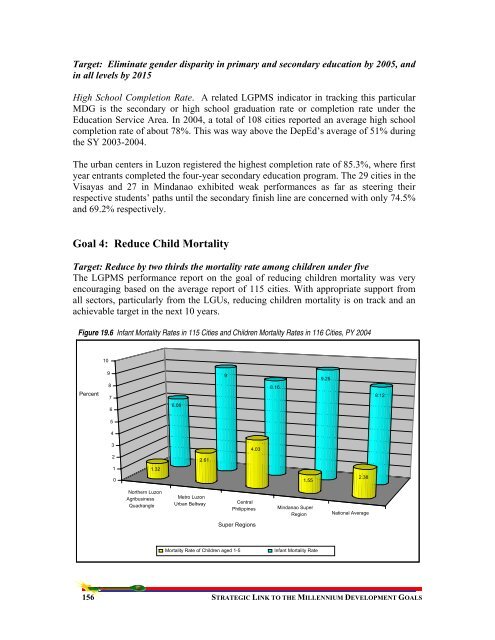19 strategic link to the millennium development goals - LGRC DILG 10
19 strategic link to the millennium development goals - LGRC DILG 10 19 strategic link to the millennium development goals - LGRC DILG 10
Target: Eliminate gender disparity in primary and secondary education by 2005, andin all levels by 2015High School Completion Rate. A related LGPMS indicator in tracking this particularMDG is the secondary or high school graduation rate or completion rate under theEducation Service Area. In 2004, a total of 108 cities reported an average high schoolcompletion rate of about 78%. This was way above the DepEd’s average of 51% duringthe SY 2003-2004.The urban centers in Luzon registered the highest completion rate of 85.3%, where firstyear entrants completed the four-year secondary education program. The 29 cities in theVisayas and 27 in Mindanao exhibited weak performances as far as steering theirrespective students’ paths until the secondary finish line are concerned with only 74.5%and 69.2% respectively.Goal 4: Reduce Child MortalityTarget: Reduce by two thirds the mortality rate among children under fiveThe LGPMS performance report on the goal of reducing children mortality was veryencouraging based on the average report of 115 cities. With appropriate support fromall sectors, particularly from the LGUs, reducing children mortality is on track and anachievable target in the next 10 years.Figure 19.6 Infant Mortality Rates in 115 Cities and Children Mortality Rates in 116 Cities, PY 200410Percent98766.0898.169.258.1254322.614.03101.321.552.38Northern LuzonAgribusinessQuadrangleMetro LuzonUrban BeltwayCentralPhilippinesMindanao SuperRegionNational AverageSuper RegionsMortality Rate of Children aged 1-5Infant Mortality Rate156 STRATEGIC LINK TO THE MILLENNIUM DEVELOPMENT GOALS
Infant Mortality Rates. IMR in 115 cities was 8.12 deaths per 1,000 live births (D/1kLB)(see Figure 19.6). The cities in the MSR recorded the highest average IMR of 9.25D/1kLB. Those in MLUB and in the CP, on the other hand, had 9.00 D/1kLB and 8.16D/1kLB, respectively. The urban centers in the NLAQ recorded the lowest IMR at 6.08D/1kLB.Children One to Five Years Old Mortality Rates. CMR for one to five years old childrenwas 2.38 deaths per 1,000 population (D/1kP) in 116 urban centers. Moreover, it washigh in the cities in the CP with an average rate of 4.03 D/1KP. This was followed bythose in the MLUB and MSR with 2.61 D/1kP and 1.55 D/1kP, respectively. Again,NLAQ recorded the lowest average at 1.32 D/1kP.Goal 5: Improve Maternal HealthTarget: Reduce by three quarters the maternal mortality ratioMaternal mortality rate is not included in the 2004 indicators of LGPMS. The efforts ofthe cities in promoting pre-natal programs are indicative of the prevailing conditions ofthe services for improving maternal health in the urban centers in the Philippines.In 2004, about 74.3% of pregnant women in 112 cities in the Philippines were providedwith pre-natal care. Urban centers in Luzon registered the highest pre-natal programcoverage of 78.4%. Cities in the Visayas and Mindanao recorded 73.0% and 69.4%,respectively.Goal 6: Combat HIV/AIDS, Malaria, and Other Infectious DiseasesTarget: Halt and begin to reverse the incidence of malaria and other major diseasesThe LGPMS report on the leading causes of morbidity in the Philippines was indicativeof the cities’ performances for MDG 6. The leading causes of morbidity in the countryinclude diarrhea with a national incidence of 1,189 per 100,000 population (/100kP);pneumonia with 939/100kP, and; bronchitis with 908/100kP. The following informationwere extracted from the 113 cities in the Philippines in 2004 (see Figure 19.7): 56 cities or 49.0% of the total had lower incidences for all the leading causes ofmorbidity 29 urban centers or 25.7% of the total had lower rates than the national levels for thetwo top diseasesSTATE OF CITIES OF THE PHILIPPINES 157Administrative Capacities, Productivity and Development Conditions
- Page 1: 19STRATEGIC LINK TO THEMILLENNIUM D
- Page 4 and 5: Figure 19.3 Malnutrition Rates in 1
- Page 8: Figure 19.7Morbidity Incidences in
- Page 11 and 12: Figure 19.10 Number of Households L
- Page 13 and 14: All the 117 urban centers had exist
Target: Eliminate gender disparity in primary and secondary education by 2005, andin all levels by 2015High School Completion Rate. A related LGPMS indica<strong>to</strong>r in tracking this particularMDG is <strong>the</strong> secondary or high school graduation rate or completion rate under <strong>the</strong>Education Service Area. In 2004, a <strong>to</strong>tal of <strong>10</strong>8 cities reported an average high schoolcompletion rate of about 78%. This was way above <strong>the</strong> DepEd’s average of 51% during<strong>the</strong> SY 2003-2004.The urban centers in Luzon registered <strong>the</strong> highest completion rate of 85.3%, where firstyear entrants completed <strong>the</strong> four-year secondary education program. The 29 cities in <strong>the</strong>Visayas and 27 in Mindanao exhibited weak performances as far as steering <strong>the</strong>irrespective students’ paths until <strong>the</strong> secondary finish line are concerned with only 74.5%and 69.2% respectively.Goal 4: Reduce Child MortalityTarget: Reduce by two thirds <strong>the</strong> mortality rate among children under fiveThe LGPMS performance report on <strong>the</strong> goal of reducing children mortality was veryencouraging based on <strong>the</strong> average report of 115 cities. With appropriate support fromall sec<strong>to</strong>rs, particularly from <strong>the</strong> LGUs, reducing children mortality is on track and anachievable target in <strong>the</strong> next <strong>10</strong> years.Figure <strong>19</strong>.6 Infant Mortality Rates in 115 Cities and Children Mortality Rates in 116 Cities, PY 2004<strong>10</strong>Percent98766.0898.169.258.1254322.614.03<strong>10</strong>1.321.552.38Nor<strong>the</strong>rn LuzonAgribusinessQuadrangleMetro LuzonUrban BeltwayCentralPhilippinesMindanao SuperRegionNational AverageSuper RegionsMortality Rate of Children aged 1-5Infant Mortality Rate156 STRATEGIC LINK TO THE MILLENNIUM DEVELOPMENT GOALS



